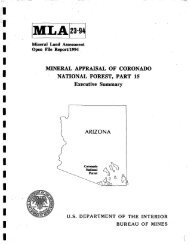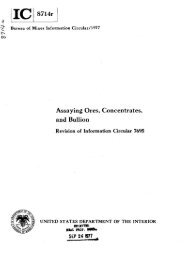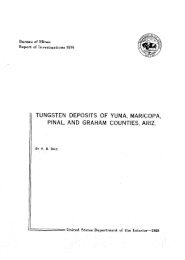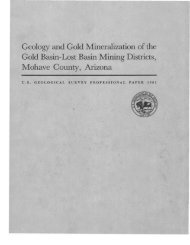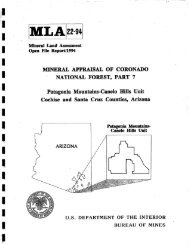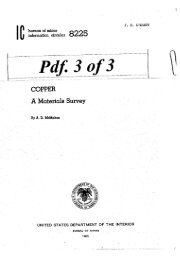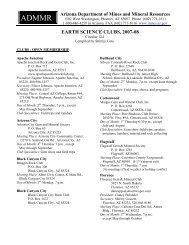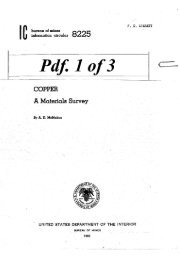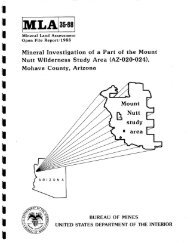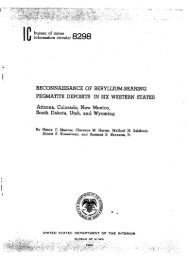MLA 56-82 - State of Arizona Department of Mines and Mineral ...
MLA 56-82 - State of Arizona Department of Mines and Mineral ...
MLA 56-82 - State of Arizona Department of Mines and Mineral ...
Create successful ePaper yourself
Turn your PDF publications into a flip-book with our unique Google optimized e-Paper software.
UNITED STATES DEPARTMENT OF THE INTERIOR<br />
BUREAU OF MINES<br />
<strong>Mineral</strong> resource potential <strong>of</strong> Mazatzal Wilderness <strong>and</strong> Contiguous<br />
Rare II Further Planning Area, Gila, Maricopa,<br />
<strong>and</strong> Yavapai Counties, <strong>Arizona</strong><br />
U.S. Bureau <strong>of</strong> <strong>Mines</strong> <strong>Mineral</strong> L<strong>and</strong> Assessment<br />
<strong>MLA</strong> <strong>56</strong>-<strong>82</strong><br />
19<strong>82</strong><br />
By<br />
Ellis, C.E.<br />
This open file report summarizes the results <strong>of</strong> a Bureau <strong>of</strong> <strong>Mines</strong><br />
wilderness study <strong>and</strong> will be incorporated in a joint report with the<br />
U.S. Geological Survey. The report is preliminary <strong>and</strong> has not been<br />
edited or reviewed for conformity with the U.S. Bureau <strong>of</strong> <strong>Mines</strong><br />
editorial st<strong>and</strong>ards. Work on this study was conduced by personnel<br />
from Intermountain Field Operations Center, Building 20, Denver<br />
Federal Center, Denver, CO 80225.
t<br />
UNITED STATES DEPARTMENT OF THE INTERIOR<br />
(BUREAU OF MINES)<br />
MINERAL-RESOURCE POTENTIAL OF THE MAZATZAL WILDERNESS<br />
AND CONTIGUOUS RARE II FURTHER PLANNING AREA, GILA,<br />
MARICOPA, AND YAVAPAI COUNTIES, ARIZONA<br />
i ¸.<br />
ii.....<br />
By<br />
Clarence E. Ellis<br />
RE-CEiVED°<br />
<strong>MLA</strong> <strong>56</strong>-<strong>82</strong><br />
19<strong>82</strong><br />
J~I ~ 7 " .......<br />
DE~"I. (.~F ".'H,'..,E:3&<br />
MI~'Ei~A,. ,x~..3OO~(CL..<br />
This open file report summarizes the results <strong>of</strong><br />
a Bureau <strong>of</strong> <strong>Mines</strong> wilderness study <strong>and</strong> will be<br />
incorporated in a Joint report with the U.S.<br />
Geological Survey. The report is preliminary <strong>and</strong><br />
has not been edited or reviewed for conformity with<br />
the U.S. Bureau <strong>of</strong> <strong>Mines</strong> editorial st<strong>and</strong>ards. Work<br />
on this study was conducted by personnel from<br />
Intermountaln Field Operations Center, Building 20,<br />
Denver Federal Center, Denver, CO 80225.<br />
/<br />
\<br />
\
%<br />
/<br />
<strong>Mineral</strong> Surveys<br />
Related to U.S. Forest Service<br />
Wilderness Areas<br />
<strong>and</strong><br />
RARE II Further Planning Areas<br />
The Wilderness Act (Public Law 88-577, September 3, 1964) <strong>and</strong> related<br />
acts require the U.S. Bureau <strong>of</strong> <strong>Mines</strong> <strong>and</strong> the U.S. Geological Survey to survey<br />
certain areas on Federal l<strong>and</strong>s to determine their mlneral-resource potential.<br />
Results must be made available to the public <strong>and</strong> be submitted to the President<br />
<strong>and</strong> the Congress. This report presents the results <strong>of</strong> a mineral-resource<br />
survey <strong>of</strong> theM azatzal Wilderness in the Tonto National Forest, Gila, Haricopa,<br />
<strong>and</strong> Yavapai Counties, <strong>Arizona</strong>. The Mazatzal Primitive Area was established<br />
under Regulation L-20 <strong>of</strong> the Secretary <strong>of</strong> Agriculture in 1938. The status<br />
was changed to wilderness ~n 1940 under Regulation U-I <strong>of</strong> the Secretary <strong>of</strong><br />
Agriculture. With passage <strong>of</strong> the Wilderness Act the Mazatzal Wilderness was<br />
incorporated into the National Wilderness Preservation System. The Mazatzal<br />
Wilderness Contiguous Roadless Area was classified as a further planning area<br />
during the Second Roadless Area Review <strong>and</strong> Evaluation (RARE II) by the U.S.<br />
Forest Service, January 1979.
CONTENTS<br />
Page<br />
Introduction.....,..,....,,.,.................,..............,....<br />
Location, size, <strong>and</strong> geographic setting .......................<br />
Mining activity ..............................................<br />
Mining districts <strong>and</strong> mineralized areas ............................<br />
Mining districts .............................................<br />
1<br />
1<br />
3<br />
3<br />
3<br />
3<br />
Sunflower............,.,......,...................,.....<br />
Mining claims ................................................<br />
Known mineralized areas ......................................<br />
Copper Mountain ................................. • .......<br />
<strong>Mineral</strong> Canyon ..........................................<br />
Copper Camp Creek .......................................<br />
Horseshoe Dam ...........................................<br />
Past <strong>and</strong> present mining activity <strong>and</strong> production data .........<br />
Resource estimates ...........................................<br />
Payson district .........................................<br />
Sunflower district ......................................<br />
Assessment <strong>of</strong> mineral-resource potential .............. • ...........<br />
Gold ........................................ • ...........<br />
Silver ..................................................<br />
Copper ..................................................<br />
Mercury ............ .... .... ... ...... ......... .... .......<br />
3<br />
4<br />
4<br />
4<br />
4<br />
5<br />
5<br />
5<br />
6<br />
7<br />
7<br />
8<br />
8<br />
10<br />
10<br />
10<br />
ii
CONTENTS-CONTINUED<br />
Page<br />
Lead ....... • .............. . ............................. 11<br />
Uranium .................................................. 11<br />
References ......... ............................................... 12<br />
ILLUSTRATIONS<br />
Plate I.<br />
Plate 2.<br />
Figure I.<br />
Figure 2.<br />
Mine <strong>and</strong> prospect map <strong>of</strong> the Mazatzal Wilderness <strong>and</strong><br />
Contiguous RARE II Further Planning Area, Gila,<br />
Maricopa, <strong>and</strong> Ya~apai Counties, <strong>Arizona</strong> ................<br />
Maps <strong>of</strong> workings in <strong>and</strong> near the Mazatzal Wilderness<br />
<strong>and</strong> Contiguous RARE II Further Planning Area ...........<br />
Index Map <strong>of</strong> the Mazatzal Wilderness <strong>and</strong> Contiguous<br />
RARE II Further Planning Area ..........................<br />
Map <strong>of</strong> the Mazatzal Wilderness <strong>and</strong> Contiguous RARE II<br />
Further Planning Area showing preliminary determination<br />
<strong>of</strong> mineral-resource potential ..........................<br />
2<br />
9<br />
iii
MINERAL-RESOURCE POTENTIAL OF THE MAZATZAL WILDERNESS AND CONTIGUOUS RARE II<br />
FURTHER PLANNING AREA, GILA, MARICOPA, AND YAVAPAI COUNTIES, ARIZONA<br />
By Clarence E. Ellis, U.S. Bureau <strong>of</strong> <strong>Mines</strong><br />
INTRODUCTION<br />
Field work was carried out by U.S. Bureau <strong>of</strong> <strong>Mines</strong> personnel Clarence E.<br />
Ellis, Don Brown, Dave Scott, Carl Almquist, John Briggs, <strong>and</strong> Mark Anders<br />
during spring <strong>and</strong> fall <strong>of</strong> 1979 <strong>and</strong> spring <strong>of</strong> 1980.<br />
Location~ slze~ <strong>and</strong> geographic setting<br />
The Mazatzal Wilderness covers 205,346 acres (831 km 2) <strong>of</strong> the Tonto<br />
National Forest in Gila, Marlcopa, <strong>and</strong> Yavapal Counties, east-central <strong>Arizona</strong><br />
(fig. I).<br />
On the west, north, <strong>and</strong> northeast sides <strong>of</strong> the Mazatzal Wilderness,<br />
the Mazatzal Wilderness Contiguous RARE II Further Planning Area covers<br />
83,750 acres (338.9 km2). The RARE II area is also part <strong>of</strong> the Tonto National<br />
Forest, <strong>and</strong> within the three named counties.<br />
Payson, Ariz., is 8 mi (13 km)<br />
east <strong>of</strong> the area, <strong>and</strong> Phoenix, Ariz., is 43 mi (69 km) south-southwest.<br />
<strong>Arizona</strong> Highway 87 is i to 8 mi (1.6 to 13 km) east <strong>of</strong> the edge <strong>of</strong> the<br />
Wilderness. The Horseshoe Dam <strong>and</strong> Verde Hot Springs roads approach the<br />
western boundary <strong>of</strong> the RARE II area.<br />
Powerline roads parallel the west side<br />
<strong>of</strong> the RARE II area <strong>and</strong> touch the southeast corner <strong>of</strong> the Wilderness.<br />
Forest<br />
Service, mine, <strong>and</strong> ranch roads reach both boundaries at many locations <strong>and</strong><br />
enter the Wilderness at the Doll Baby Ranch on the East Verde River.<br />
The Verde River flows through the RAKE II area west<strong>of</strong> the Wilderness, <strong>and</strong><br />
the East Verde River cuts through the northern third <strong>of</strong> the Wilderness.<br />
Eleva-<br />
tion ranges from 7,903 ft (2,409 m) on Mazatzal Peak to about 2,200 ft (670 m)<br />
near Horseshoe Reservlor.
\<br />
p.<br />
,r... J<br />
f-,.<br />
rJ -j<br />
I<br />
I~y,t, on<br />
TY<br />
N<br />
COUNT'f<br />
I<br />
EXPLANATION<br />
Mozol"zol Wilderness boundary<br />
RARE 1Z Further Pionning<br />
Arso boundory<br />
Borl"le'~<br />
'T'O PH~NIX<br />
MILES<br />
/<br />
'<br />
I0 MILES<br />
h t ' , I , i I<br />
i<br />
0 ~ PD ~ KILOMETERS<br />
LOCAT)ON MAP<br />
}igure<br />
l.-Index map <strong>of</strong><br />
~he Mazatza! Wilderness<br />
FurLh~r piannl:Lg Area.<br />
<strong>and</strong> Contiguous ILA~E II
Minin~ activity<br />
Mining activity in the area peaked in the 1880's, <strong>and</strong> has since remained<br />
at a low level.<br />
In 1979, an adit was being driven at the Sunflower Mine<br />
(Plate I), <strong>and</strong> the road to the Casterson Mine was being repaired; both activ-<br />
ities, however, were curtailed by 1980.<br />
In recent years there has been<br />
trenching at the Sunflower Mine; drilling <strong>and</strong> trenching at <strong>Mineral</strong> Canyon on<br />
the eastern boundary; trenching,<br />
geochemical, <strong>and</strong> geophysical prospecting,<br />
<strong>and</strong> minor copper-silver production at Copper Mountain inside the Wilderness;<br />
drilling for uranium near Horseshoe Dam near the RAKEll area; <strong>and</strong> applications<br />
were filed with the ~.S. Forest Service for permission to drill at Copper<br />
Camp Creek inside the Wilderness.<br />
MINING DISTRICTS AND MINERALIZED AREAS<br />
Mining Districts<br />
Payson<br />
The Payson, or Green Valley, mining district (Plate 1) surrounds Payson,<br />
except on the north.<br />
The part <strong>of</strong> the district adjacent to the Wilderness<br />
extends from Just north <strong>of</strong> the East Verde River, to Eisenhauer Canyon on the<br />
south.<br />
Near the eastern Wilderness boundary, on gold-bearing quartz veins<br />
in a variety <strong>of</strong> igneous rocks <strong>of</strong> Precambrian age, are the Casterson, Collom,<br />
Crackerjack, Gowan, <strong>and</strong> House <strong>Mines</strong> (Plate 2).<br />
Except for the Gowan vein,<br />
which is traceable for possibly a half mile (800 m), the veins in these<br />
mines pinch out along strike within a few hundred feet (tens <strong>of</strong> meters), but<br />
extend deeper than the limits <strong>of</strong> development.<br />
They appear to fill tension<br />
gashes related to nearby major faults.<br />
Sunflower<br />
The Sunflower mercury district (Plate I) is in an east-northeast-trending<br />
belt <strong>of</strong> Precambrian schist (Ransome, 1915) <strong>of</strong> the Alder Group near the south-<br />
east corner <strong>of</strong> the Wilderness.<br />
Just inside the Wilderness, volcanic rocks<br />
3
cover the schist.<br />
The Cornucopia, Gold Creek, Mercuria, Oneida, Pine Butte,<br />
Pine Mountain, <strong>and</strong> Sunflower <strong>Mines</strong> (Plate 2) are near the Wilderness.<br />
Although<br />
on the mercury trend, the Storey Mine inside the Wilderness,<br />
is a silver-<br />
lead-gold deposit.<br />
Lithology or stratigraphy, rather than structure appears<br />
to have controlled ore deposition.<br />
Mining Claims<br />
A patented claim, the Blue Lode(?), is located inside the Wilderness in<br />
sec. I0, T. 9 N., R. 7 E.<br />
Large blocks <strong>of</strong> unpatented claims are at Copper<br />
Mountain, Copper Camp Creek, <strong>Mineral</strong> Canyon, Horseshoe Dam, Sunflower, <strong>and</strong><br />
House Creek.<br />
Because few old claim descriptions are definitive, many ,Lines<br />
<strong>and</strong> prospects cannot be correlated with claims.<br />
Known <strong>Mineral</strong>ized Areas<br />
Copper Mountain<br />
Just south <strong>of</strong> the East Verde River, <strong>and</strong> 1 to 5 mi (1.6 to 8 km) inside<br />
the Wilderness, the Copper Mountain group consists <strong>of</strong> a block <strong>of</strong> over I00<br />
claims. Several miles <strong>of</strong> bulldozer roads, a Ii0- by 60- by 100-ft-deep<br />
(32- by 20- by 30-m-deep) open cut, <strong>and</strong> many old workings that are caved except<br />
for three short adits occur within the claim block.<br />
West <strong>of</strong> Bullfrog Canyon,<br />
silver is dominant in faults <strong>and</strong> sheared quartz veins in graywackes <strong>and</strong><br />
siltstones near major faults.<br />
East <strong>of</strong> Bullfrog Canyon, the copper minerals<br />
chalcopyrite, bornite, <strong>and</strong> copper oxides are dominant, occurring as dissemi-<br />
nations, blebs, <strong>and</strong> disseminations in quartz veins.<br />
Country rocks are maflc<br />
volcanlcs.<br />
<strong>Mineral</strong> Canyon<br />
A network <strong>of</strong> bulldozer roads covers the spur ridge on the north side <strong>of</strong><br />
<strong>Mineral</strong> Canyon <strong>and</strong> extends into the Wilderness.<br />
A block <strong>of</strong> <strong>56</strong> claims covering<br />
this area has been known variously as the Big Penny <strong>and</strong> Big Bear group.<br />
4
Freeport Exploration Co., Miami Copper Co., Phelps Dodge Corp., Phoenix<br />
Ventures, Pinal Copper Corp., <strong>and</strong> Viola Mac examined the property between<br />
1957 <strong>and</strong> 1977. Disseminated copper oxides, occur in a brecciated complex <strong>of</strong><br />
intermediate volcanic <strong>and</strong> plutonlc rocks near a major fault intersection.<br />
The<br />
mineralized zone extends at least<br />
1,500 ft (460 m) into the Wilderness.<br />
Copper Camp Creek<br />
Copper oxides are found at the Copper Cliff group <strong>of</strong> 22 claims in the<br />
center <strong>of</strong> the southern quarter <strong>of</strong> the Wilderness.<br />
Over a dozen pits <strong>and</strong><br />
trenches, a 60-ft (20-m) shaft, <strong>and</strong> a 390-ft (120-m) adit are in the mineral-<br />
ized zone.<br />
Drilling was proposed by the claim owners in 1972, <strong>and</strong> recommended<br />
by a U.S. Forest Service examiner (U.S.F.S., 1973), but never carried out.<br />
Country rocks are Alder Group, mostly <strong>of</strong> volcanic derivation.<br />
Horseshoe Dam<br />
Low-grade uranium occurrences are present in Tertiary lake-basln sedi-<br />
ments east <strong>of</strong> Horseshoe Dam.<br />
Two blocks <strong>of</strong> 150 claims each have been located,<br />
<strong>and</strong> at least three holes drilled.<br />
Some <strong>of</strong> these claims are in the RARE II<br />
area.<br />
A sample taken across a 4 in. (I0 cm) bed assayed 165-ppm U308, but<br />
the next highest assay from beds in this basin was only 18 ppm.<br />
Past <strong>and</strong> Present Mining Activity <strong>and</strong> Production Data<br />
Gold was discovered in about 1875 near Payson, <strong>and</strong> the Payson mining<br />
district had its peak between 1881 <strong>and</strong> 1886 (Lausen <strong>and</strong> Wilson, 1925).<br />
Pro-<br />
duction from that period was not recorded.<br />
The district was more or less<br />
idle until the 1930's, after which there was sporadic production.<br />
Between<br />
1938 <strong>and</strong> 19<strong>56</strong> the Casterson, Collom, Crackerjack, <strong>and</strong> Gowan <strong>Mines</strong> produced<br />
(USBM Files):<br />
gold: 199 oz (6,190 g)<br />
silver: 426 oz (13.2 kg)<br />
copper: 17,596 Ib (7,990 kg)
In 1967, 33.5 tons (30.4 t) <strong>of</strong> ore containing 938 lb (426 kg) <strong>of</strong> copper <strong>and</strong><br />
485 oz (15.1 kg) <strong>of</strong> silver were produced from the Copper Mountain open cut<br />
(USFS files).<br />
Exploration for copper has been moderately active at <strong>Mineral</strong> Canyon from<br />
19<strong>56</strong> to 1977, at Copper Mountain from 1964 to present, at Copper Camp Creek<br />
from 1955 to 1972, <strong>and</strong> at EisenhauerCanyon in 1957.<br />
Increasing precious metal<br />
prices have spurred renewed activity at several properties near Payson.<br />
Mercury was discovered in the Sunflower mining district in October, 1911,<br />
(Ransome, 1915), which has remained Intermittantly active until the present,<br />
although there has been little production since the 1960's. At present the<br />
only activity is at the Sunflower Mine.<br />
The Pine Mountain <strong>and</strong> Sunflower <strong>Mines</strong> were the ma~or mercury producers<br />
near the Wilderness.<br />
tities <strong>of</strong> mercury.<br />
Other properties combined have contributed minor quan-<br />
The Storey (Tri-Metals) Mine produced no mercury, <strong>and</strong><br />
various mercury mines produced gold, silver, <strong>and</strong> Copper.<br />
Recorded production<br />
(USBM <strong>and</strong> USFS Files except as noted) from 1913 to 1965 is:<br />
mercury:<br />
gold:<br />
silver:<br />
copper:<br />
lead:<br />
3,973 flasks<br />
764 oz<br />
1,095 oz<br />
2,140 Ib<br />
27,650 Ib<br />
(137 t) (Beckman <strong>and</strong> Kerns, 1965)<br />
(23.8 kg)<br />
(34.1 kg)<br />
(970 kg)<br />
(12.5 t)<br />
Resource Estimates<br />
Deposits in, or within a half mile (0.8 km) <strong>of</strong> the Wilderness or RARE II<br />
area are listed here.<br />
Estimates are based on Bureau <strong>of</strong> <strong>Mines</strong> mapping <strong>and</strong><br />
570 Bureau <strong>of</strong> <strong>Mines</strong> samples taken in area. At the time <strong>of</strong> the study--1979 to<br />
1981--ali resources except the<br />
Storey Mine were sub-economlc.
Payson District<br />
Combined inferred resources <strong>of</strong> the Casterson <strong>and</strong> Collom <strong>Mines</strong>, Just outside<br />
the Wilderness, are 52,000 tons (47,000 t) containing 0.07 oz <strong>of</strong> gold <strong>and</strong><br />
0.7 oz <strong>of</strong> silver per ton (2.3 g <strong>of</strong> gold <strong>and</strong> 25 g <strong>of</strong> silver per metric ton).<br />
Copper Mountain has a moderate size copper-silver resource entirely<br />
inside the Wilderness.<br />
The mlnerallzed area is 8,000 by 200 ft (2,400 by<br />
60 m) with hlgh-grade spots.<br />
<strong>Mineral</strong> Canyon has a moderate size copper resource which is partly inside<br />
the Wilderness.<br />
The mineralized area is 3,000 by 800 ft (900 by 240 m).<br />
Sunflower District<br />
The Sunflower Mine has an inferred resource <strong>of</strong> 26,000 tons (24,000 t)<br />
containing 0.14-percent mercury Just outside the Wilderness, <strong>and</strong> an inferred<br />
resource <strong>of</strong> 3,600 tons (3,300 t) containing 0.21-percent mercury Just inside<br />
the Wilderness.<br />
Inside the Wilderness, the Storey Mine has an inferred resource <strong>of</strong> 78,000<br />
tons (71,000 t) containing 0.06 oz <strong>of</strong> &old <strong>and</strong> 1.9 oz <strong>of</strong> silver per ton (2.1E<br />
<strong>of</strong> gold <strong>and</strong> 65 g <strong>of</strong> silver per metric ton) <strong>and</strong> 3.9-percent lead.<br />
This resource<br />
is calculated from surface exposures, as the workings are all caved.<br />
The<br />
known production has been subtracted from the calculated resource, however,<br />
any unrecorded production which may have occurred would also subtract from<br />
the quantity stated.<br />
Copper Camp Creek has a moderate sizecopper resource entirely inside the<br />
Wilderness.<br />
The mineralized area is 3,000 by 200 ft (900 by 60 m).
@<br />
ASSESSMENT OF MINERAL-RESOURCE POTENTIAL<br />
This is a preliminary assessment based on Bureau <strong>of</strong> <strong>Mines</strong> data gathered<br />
during this investigation. Figure 2 shows the areas determined to have<br />
mlneral-resource potential. For purposes <strong>of</strong> this report the following<br />
definitons are used: small resources/reserves - less than 100,000 tons<br />
(91,000 t), medlum-size resources/reserves - 100,000 to one million tons<br />
(91,000 to 910,000 t), large resources/reserves-more than I mi11ion tons<br />
(910,000 t).<br />
The Hazatzal Wilderness has copper, mercury, silver, gold, <strong>and</strong> lead<br />
resources. Dense chaparall <strong>and</strong> rugged terrain inhibit prospecting now, as in<br />
the past, <strong>and</strong> exploration would be dlfflcult<br />
<strong>and</strong> costly.<br />
Cold<br />
Gold has been mined from quartz veins in Precambrlan rocks lying near the<br />
Deadman, Verde, <strong>and</strong> Sheep Mountain faults<br />
mapped by Wrucke <strong>and</strong> Conway (in<br />
preparation) <strong>and</strong> the Payson granite.<br />
Except for the Gowan vein, these veins<br />
persist only a few hundred feet (tens <strong>of</strong> meters) along strike. No pinching<br />
<strong>of</strong> the veins down-dip was observed by the Bureau <strong>of</strong> <strong>Mines</strong>, nor was it reported<br />
by Lausen'<strong>and</strong> Wilson (1925). Only free-milling gold was recoverable when<br />
the Payson district was active; therefore, development rarely proceeded<br />
more than tens <strong>of</strong> feet below the oxidized part <strong>of</strong> the vein.<br />
Vein configuration<br />
<strong>and</strong> proximity to the faults mentioned suggest that these veins filled<br />
tension<br />
gashes related to fault movement.<br />
A moderate potential for gold exists in small- to medlum-slze, high - to<br />
moderate-grade veins in Precambrian rocks near these faults.<br />
Gold is expected<br />
as a byproduct <strong>of</strong> copper or mercury deposits.<br />
" B
~ p<br />
i.<br />
1.:<br />
P<br />
"J ' I<br />
~ Poyson<br />
.~ PAYSON DISTRICT<br />
/<br />
YAVAPAt I ~,OUNTY<br />
N<br />
, ?<br />
.,-,, _=~___~~ri-., ~<br />
I MARICO~ COUNTY<br />
A<br />
SUNFLOWER DISTRICT<br />
' ~<br />
x L A o<br />
-" Mozotzol Wik~w~;s boundory<br />
~. .,,,--.- ---,. RARE ~ Further Pmnning<br />
Aroo Imundory<br />
Bo~/e~ ~ Identified resource<br />
Fii~.r~rvoi~ ~ ( ~ ~ Modero'l-e po't-erM'ia t<br />
TO r..,-mO,,-S. N~;<br />
I I J<br />
| J Jt t I t<br />
6 5 io I~) KtLO~TERS<br />
Figure 2.-Map <strong>of</strong> the Mazatzal Wilderness <strong>and</strong> Contiguous RARE II Further<br />
Planning Area sho~'ing preliminary determination <strong>of</strong><br />
mineral-resource potential.<br />
g
Silver<br />
Silver accompanies gold in the vein systems described above, <strong>and</strong> would be<br />
a byproduct <strong>of</strong> mining copper or mercury deposits.<br />
Relationships <strong>of</strong> silver to<br />
copper are unclear west <strong>of</strong> Bullfrog Canyon in the sedimentary sequence <strong>of</strong><br />
the Copper Mountain deposit.<br />
With this exception, silver potential is related<br />
directly to gold, mercury, <strong>and</strong> copper potential.<br />
Copper<br />
Some copper may be syffgenetlc with Precambrian volcanic-sedimentary rocks<br />
(upper Alder Group <strong>and</strong> Yavapai(?) Group), but if so, it is very spotty.<br />
Con-<br />
centrations <strong>of</strong> copper from the Payson granite <strong>and</strong> the possible older sources<br />
are localized in hrecciated zones related to intersection <strong>of</strong> the Verde <strong>and</strong><br />
Deadman Fault, intersection <strong>of</strong> the Sheep Mountain Fault <strong>and</strong> local faults<br />
related to Tertiary plugs, or in permeable host rocks near major faults <strong>and</strong><br />
the granite,<br />
A moderate potential for copper exists in medium-size, low- to moderategrade<br />
deposits in basic- to intermediate-volcanic rocks <strong>of</strong> Precambrian age<br />
which are near structural intersections <strong>and</strong> the Payson granite.<br />
A moderate<br />
potential for copper in small, high-grade deposits exists in Precambrlan<br />
basic- to intermediate-volcanic rocks.<br />
area is not a porphyry copper environment.<br />
The Mazatzal Wilderness <strong>and</strong> RARE II<br />
Some copper would be a byproduct <strong>of</strong><br />
mining gold-silver veins, <strong>and</strong> rarely might be recovered from mercury deposits.<br />
Mercury<br />
Alder Group rocks are the only host in this area for more than trace<br />
amounts <strong>of</strong> mercury.<br />
Quartz-sericite or chlorite schists are favored, probably<br />
due to permeability <strong>of</strong> the beds, or between the beds.<br />
The mercury, probably<br />
derived from the Payson granite <strong>and</strong> remobilized by the heat from Tertiary<br />
10
w<br />
4<br />
stocks, was driven along permeable paths In the Alder Group beds. Deposition<br />
was probably a function <strong>of</strong> temperature.<br />
A moderate potential for mercury in small, low- to moderate-grade<br />
deposits exists in the Precambrian Alder Group in proximity to the Payson<br />
granite, Sheep Mountain Fault <strong>and</strong> a Tertiary stock, which is to say within<br />
the present Sunflower district.<br />
Lead<br />
Lead is a major constituent<br />
<strong>of</strong> the Storey <strong>and</strong> Stingy Lady veins, but ts<br />
otherwise uncommon in the Mazatzal Wilderness <strong>and</strong> RARE II area. These<br />
veins are short along strike, but their behavior along dip is unknown. Both<br />
are near major faults; the Storey is near the Payson granite, <strong>and</strong> the Stingy<br />
Lady within it.<br />
A low potential exists for lead In small, high-grade vein deposits In<br />
Precambrian rocks in or near the Payson granite near major faults.<br />
Uranium<br />
Anomalous, but very low-grade uranium is found in tuffaceous s<strong>and</strong>stones<br />
in a Tertiary basln-fill.<br />
A moderate potential for uranium in medium-size,<br />
low-grade deposits exists in the Tertiary sediments in the Verde River valley,<br />
particullarly in the area receiving detritus from the uranium-bearing stock<br />
in Tangle Creek.<br />
11
REFERENCES<br />
Beckman, R. T., <strong>and</strong> Kerns, W. H., 1965, Mercury in <strong>Arizona</strong>, in Mercury<br />
potential <strong>of</strong> the United <strong>State</strong>s: U.S. Bureau <strong>of</strong> <strong>Mines</strong> Information<br />
Circular <strong>82</strong>52.<br />
Frederick, F. H., 1964, Report on the Pine Mountain Mercury Mine, Maricopa<br />
County, <strong>Arizona</strong>: unpublished report in U.S. Bureau <strong>of</strong> <strong>Mines</strong> files,<br />
Denver, Colorado.<br />
Lausen, C., <strong>and</strong> Gardner, E. D., 1927, Quicksilver resources <strong>of</strong> <strong>Arizona</strong>:<br />
<strong>Arizona</strong> Bureau <strong>of</strong> <strong>Mines</strong> Bulletin 122.<br />
Lausen, C., <strong>and</strong> Wilson, E. D., 1925, Gold <strong>and</strong> copper deposits near Payson,<br />
<strong>Arizona</strong>: <strong>Arizona</strong> Bureau <strong>of</strong> <strong>Mines</strong> Bulletin 120.<br />
Ransome, F. L., 1915, Quicksilver deposits <strong>of</strong> the Mazatzal Range, <strong>Arizona</strong>:<br />
U.S. Geological Survey Bulletin 620.<br />
U.S. Forest Service, 1973, A mineral exploration proposal in the Mazatzal<br />
Wilderness: Final Environmental <strong>State</strong>ment.<br />
Wrucke, C., <strong>and</strong> Conway, C., in preparation, Geologlcalmap <strong>of</strong> the Mazatzal<br />
Wilderness <strong>and</strong> contiguous RARE II Further Planning Area, Gila, Marlcopa,<br />
<strong>and</strong> Yavapal Counties, <strong>Arizona</strong>: U.S. Geological Survey MF map.<br />
12



